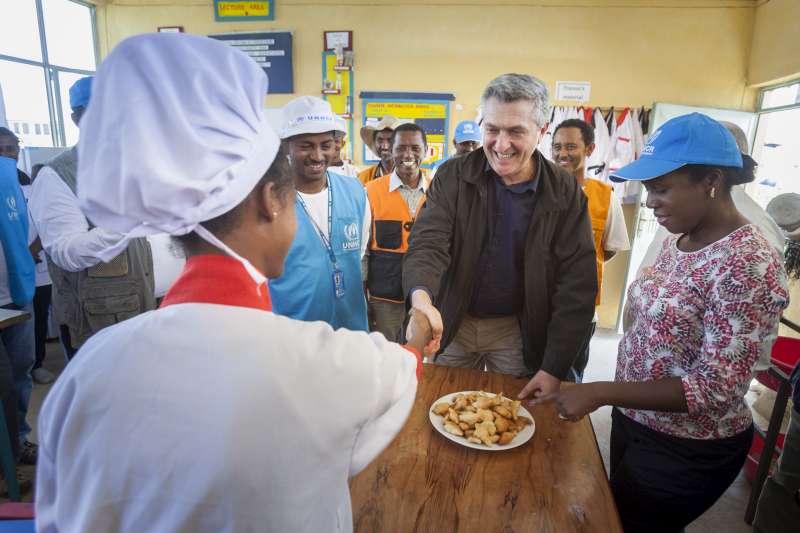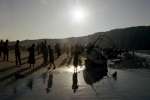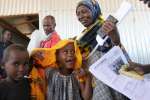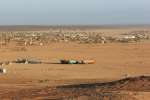- Text size
 |
|  |
|  |
| 
- عربي
Do not risk your lives, Grandi tells Eritrean refugees
News Stories, 2 February 2016
SHIRE, Ethiopia, Feb 2 (UNHCR) – Improving conditions for refugees in camps and expanding programmes for legal pathways outside Ethiopia were both key to reducing the numbers who attempt perilous journeys to reach safety, Filippo Grandi, the UN High Commissioner for Refugees, said as he met Eritreans who fled to Ethiopia.
After Syrians, Afghans, and Iraqis, Eritreans were the fourth most common group of refugees trying to cross the Mediterranean to Europe in 2015. On his first trip to Africa as High Commissioner, Grandi visited Hitsats camp, one of four hosting Eritreans in Ethiopia's northern highlands.
The refugees there told Grandi that their mostly young population would not fall prey to smugglers and human traffickers if, after fleeing from their homes, they found more reasons beyond simple security to stay in the refugee settlements in Ethiopia. Education and promises of productive life elsewhere were the priorities, they said.
Their experience is matched by millions of other people fleeing conflict and persecution who find themselves initially sheltered in locations where the lack of opportunity often drives them to leave again in search of a future.
"We will do our best to create opportunities here and to improve resettlement placements and other legal ways of migration so that refugees will not expose themselves to danger," Grandi said during his visit to Hitsats.
"Your points are well taken and please rest assured that I will do my best to call attention to your situation so we can mobilise more resources and improve the living conditions in the camps."
Ethiopia looks after 734,000 mostly South Sudanese, Somali, and Eritrean refugees, more than any other country in Africa. Some 155,000 of them are Eritrean, and many report fleeing home out of fear.
Hagos*, who is 26 and arrived in Hitsats in 2014, said he was forced to serve in the Eritrean army for seven years, much longer than the national service to which he initially thought he was committed.
"I would not object to the mandatory national service if the government respected the 18-month term limit," said Hagos. Instead, he was paid a pittance, could not leave, and added: "As if this was not injustice enough, the commanders violate our rights every day, hence my decision to flee."
Hagos said he hid during the day and walked only under cover of darkness during the 10 days it took him to reach Ethiopia. He found safety at Hitsats, but said life still carried challenges. "I completed 12th grade at school before joining the army and here there is no way I could continue my education," he said, adding a plea for better opportunities for continued education, or vocational training, at the camp.
He is not alone in requesting the chance to continue schooling. Of the nearly 38,000 refugees living in the four camps near the town of Shire here, three quarters are aged under 25, and many of those are teenagers and children.
One 16-year-old, Kidan*, described how she fled on her own from Eritrea in 2014 but decided after only a few months in Ethiopia to find a smuggler – called a 'pilot' here – to take her to Europe.
"Frustrated by the difficulties of life in Hitsats, I contacted a pilot and travelled on foot for many days and nights before we got to the border with Sudan, hungry and thirsty," she said.
After crossing through her homeland and making it close to its border with Sudan, Eritrean guards caught and detained her for several days. The authorities eventually released her, but made her mother sign a guarantee that she would pay 90,000 nafka, the equivalent of several thousand dollars, if her daughter fled again.
Nonetheless, life at home was so difficult that Kidan again made the journey to Ethiopia, with her mother and siblings soon following her out of fear that the authorities would track them down, demand the money, and likely imprison them when they could not pay.
Recent surveys in the six refugee camps hosting Eritreans in Ethiopia found that 82,000 were no longer present in the camps and were so far unaccounted for. It is expected that few would have tried voluntarily to return to Eritrea. Some may be in other parts of Ethiopia, while the rest may have joined the ranks of those trying to reach Europe. UNHCR is working with the Ethiopian government's refugee agency, the Administration for Refugee and Returnee Affairs, or ARRA, to track down these individuals.
Better schooling, more vocational training, and the promise of resettlement would stop those refugees and others like Kidan and Hagos from attempting these dangerous journeys, Grandi was told during his visit. He was accompanied by Ayalew Aweke, the Deputy Director of ARRA, Valentin Tapsoba, the Director of UNHCR's Africa Bureau, and Clementine Nkweta-Salami, the UNHCR Representative in Ethiopia.
Grandi's visit to Ethiopia was his first to Africa since taking office as High Commissioner at the start of 2016. Earlier, he attended the 26th African Union Summit in the capital, Addis Ababa, and met with Ethiopia's Prime Minister, Hailemariam Desalegn, whom he thanked for the country's ongoing welcome to people fleeing hardship across the region.
"Notwithstanding its current challenges related to the severe drought affecting certain parts of the country, Ethiopia continues to maintain an open door policy and is hosting the largest refugee population in Africa today," Grandi said.
By Kisut Gebre Egziabher in Shire, Ethiopia
* Names have been changed for security and protection
















































